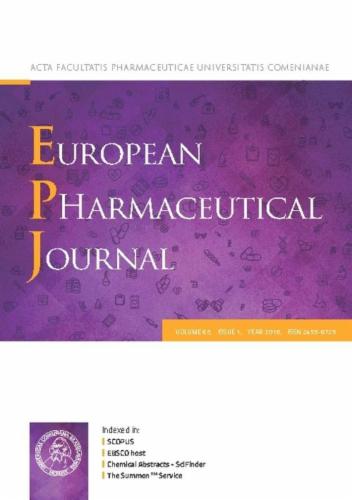以聚-(D, l -丙交酯-羟基乙酸酯)纳米颗粒为载体增强组蛋白去乙酰化酶抑制剂罗米地辛体外抗白血病作用。
IF 4.3
3区 医学
Q1 PHARMACOLOGY & PHARMACY
引用次数: 0
摘要
本研究旨在建立以聚(D, l -丙交酯-共糖醇酯)为载体的组蛋白去乙酰化酶抑制剂(HDACi)罗米地辛(ROM)的递送系统,并评价其抗白血病作用。采用单乳液-溶剂蒸发技术制备了罗米地辛负载纳米颗粒(ROM NPs)。研究了它们的物理特性和体外药物释放谱,以及生物相容性和血液相容性评估。通过细胞活力测定和膜联蛋白V/碘化丙啶(PI)染色评价ROM NPs体外抗白血病和诱导细胞凋亡的效果。ROM纳米粒子呈球形,平均水动力尺寸约为149.7±8.4 nm, PDI为0.11±0.03,zeta电位为-25.27±2.12 mV。纳米颗粒表现出ROM的高封装效率(约93%),这些纳米颗粒有效地进入急性白血病细胞,包括U937和Jurkat。ROM NPs还表现出延长的双相释放模式,特别是,最初的爆发释放阶段发生在前24小时内,随后是较慢的持续释放。此外,它们没有血液学或生物毒性,表明它们在通过循环系统输送抗癌药物方面的潜在用途。在对急性白血病细胞系的实验中,ROM NPs显示出比游离ROM更强的抗白血病作用,并在更大程度上诱导细胞凋亡。综上所述,ROM NPs具有增强的抗白血病作用,是一种很有前景的白血病治疗选择。可以对该策略进行进一步修改以实现靶特异性,从而最大限度地减少对正常细胞的损伤。本文章由计算机程序翻译,如有差异,请以英文原文为准。

Enhancement of the in vitro anti-leukemic effect of the histone deacetylase inhibitor romidepsin using Poly-(D, L-lactide-co-glycolide) nanoparticles as a drug carrier
The goal of this work is to develop a delivery system for histone deacetylase inhibitor (HDACi) romidepsin (ROM) using Poly(D, L-lactide-co-glycolide) as a carrier and evaluate its anti-leukemic effects. Romidepsin-loaded nanoparticles (ROM NPs) required for this purpose were fabricated using a single emulsion-solvent evaporation technique. Their physical characteristics and in vitro drug release profiles were studied, alongside biocompatibility and hemocompatibility assessments. Cell viability assays and Annexin V/Propidium Iodide (PI) staining were conducted to evaluate the anti-leukemic and apoptosis induction efficiency of ROM NPs in vitro. ROM NPs displayed a spherical shape with an average hydrodynamic size of about 149.7 ± 8.4 nm, a PDI of 0.11 ± 0.03, and a zeta potential of -25.27 ± 2.12 mV. The nanoparticles demonstrated a high encapsulation efficiency of ROM (∼93 %) and these nanoparticles effectively entered acute leukemia cells, including U937 and Jurkat. ROM NPs also exhibited a prolonged biphasic release pattern, specifically, the initial burst release phase occurred within the first 24 h, followed by a slower, sustained release. Additionally, they showed no hematological or biological toxicity, indicating their potential use for the delivery of anti-cancer drugs through the circulatory system. In tests on acute leukemia cell lines, ROM NPs showed significantly stronger anti-leukemic effects and induced apoptosis to a greater extent compared to free ROM. In summary, ROM NPs represent a promising therapy option for leukemia according to their enhanced anti-leukemic effects. Further modification of this strategy could be performed to enable target specificity, hence minimizing damage to normal cells.
求助全文
通过发布文献求助,成功后即可免费获取论文全文。
去求助
来源期刊
CiteScore
9.60
自引率
2.20%
发文量
248
审稿时长
50 days
期刊介绍:
The journal publishes research articles, review articles and scientific commentaries on all aspects of the pharmaceutical sciences with emphasis on conceptual novelty and scientific quality. The Editors welcome articles in this multidisciplinary field, with a focus on topics relevant for drug discovery and development.
More specifically, the Journal publishes reports on medicinal chemistry, pharmacology, drug absorption and metabolism, pharmacokinetics and pharmacodynamics, pharmaceutical and biomedical analysis, drug delivery (including gene delivery), drug targeting, pharmaceutical technology, pharmaceutical biotechnology and clinical drug evaluation. The journal will typically not give priority to manuscripts focusing primarily on organic synthesis, natural products, adaptation of analytical approaches, or discussions pertaining to drug policy making.
Scientific commentaries and review articles are generally by invitation only or by consent of the Editors. Proceedings of scientific meetings may be published as special issues or supplements to the Journal.

 求助内容:
求助内容: 应助结果提醒方式:
应助结果提醒方式:


